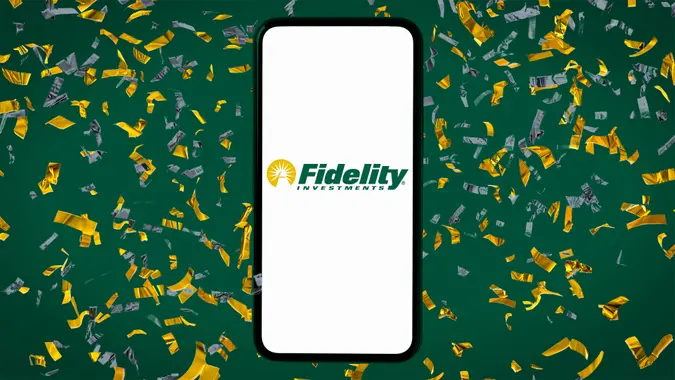6 Best No Penalty CD Rates for October 2024

Commitment to Our Readers
GOBankingRates' editorial team is committed to bringing you unbiased reviews and information. We use data-driven methodologies to evaluate financial products and services - our reviews and ratings are not influenced by advertisers. You can read more about our editorial guidelines and our products and services review methodology.

20 Years
Helping You Live Richer

Reviewed
by Experts

Trusted by
Millions of Readers
Interest rates are higher than they’ve been in years. That’s good news if you want to stash some cash in a certificate of deposit, but there’s more to choosing the best CD than earning interest alone. Most CDs apply a penalty of three months’ interest if you withdraw the money before the maturity date, which can negate the advantage of higher rates of a traditional CD.
If you’ve weighed the pros and cons and you like the idea of a CD — including higher interest, a fixed rate that’s guaranteed for the term of the deposit and FDIC insurance — but are concerned that you might want to take the money out before the end of the term, consider a no-penalty CD.
Best No-Penalty CD Rates
Outside of high-yield savings or money market accounts, no-penalty CDs offer competitive rates as a low-risk investment. Here are some top-paying no-penalty CDs and the rates they are paying.
| Financial Institution | Minimum Deposit Requirement | Term | APY |
|---|---|---|---|
| US Alliance Financial | $500 | 11 months | 4.8% |
| Sallie Mae, powered by Raisin | $1 | 14 months | |
| America First Credit Union | $500 | 12 months | |
| CIT Bank | $1,000 | 11 months | |
| Ally Bank | $0 | 11 months | |
| Marcus by Goldman Sachs, Member FDIC | $500 | 13 months |
US Alliance Financial
- APY: 4.8%
- Minimum Deposit: $500
US Alliance Financial offers an 11-month no-penalty CD with 4.8% APY. The CD has a $500 minimum deposit. You must be a member of the credit union to open a CD.
Raisin
- APY: 4.4%
- Minimum Deposit: $1
Raisin (formerly SaveBetter) is partnering with Sallie Mae Bank to offer a 14-month no-penalty CD that pays 4.4% APY. The minimum opening deposit is just $1. The CD allows a one-time full withdrawal beginning 30 days after the account is opened.
America First Credit Union
- APY: 4.8%
- Minimum Deposit: $500
America First Credit Union offers a 12-month Flexible Certificate, which allows one penalty-free withdrawal during the first five days of each quarter. You can also add up to $10,000 per month to this CD, for a total balance of up to $100,000. This certificate pays 4.8% Credit Union: Flexible Certificate – Primary Rate (text)”> APY, and you must have a $500 minimum deposit to open it. You must also be a credit union member.
CIT Bank
- APY: 3.5%
- Minimum Deposit: $1,000
CIT Bank offers an 11-month no-penalty CD that pays 3.5% APY. This account comes with daily compounding and no monthly fees. The minimum required to open a CD is $1,000.
Ally Bank
- APY: 4%
- Minimum Deposit: $0
Ally Bank offers an 11-month CD that pays 4% APY and doesn’t impose a penalty for withdrawing the money early. There’s no minimum deposit required to open a CD at Ally Bank.
If you choose to renew your CD for another term, you might be eligible for a Loyalty Reward rate boost for a higher APY on your next term.
Marcus by Goldman Sachs
- APY: 4.4%
- Minimum Deposit: $500
Marcus by Goldman Sachs has a no-penalty CD that pays APY and allows you to withdraw your funds after just seven days. The CD has a 13-month term and a $500 minimum opening deposit.
What Is a No-Penalty CD?
When you put your money into a CD, you select how long you’ll leave the money on deposit with the bank, known as the term. CD terms typically range from three months to five years, with lots of options in between.
With a regular CD, the bank likes to know that the money will be there for the length of time specified, so it will usually charge you if you take it out early. The standard penalty is three months’ worth of interest, although some banks will charge more for longer-term CDs. So, if you buy a three-month CD and take it out after two, you’ll lose money. If you take out your five-year CD after four years, you’ll still get interest, but less of it — three years and nine months’ worth instead of four years’ worth.
On the other hand, a no-penalty CD lets you take your money out without losing any of the accrued interest. While no-penalty CDs usually have restrictions on how soon you can withdraw money penalty-free, you won’t have to wait long — less than a week in some cases.
How Does a No-Penalty CD Work?
Say you like the high rates available for a CD but you worry about losing access to your money for months or years. You could withdraw your money if needed, but you’d do so at the expense of some of your interest, defeating the purpose of opening a CD.
One option is to open a no-penalty CD. The rate might be slightly lower than an equivalent standard CD, but in return, you can withdraw your money without losing any of your accrued interest. So you open the CD — perhaps one with a 12-month term — but after just six months you realize you need to make a withdrawal.
What happens next depends on the bank or credit union where you opened the CD. Most require that you withdraw all your money, effectively closing the account. Others allow you to take out just part of your balance. America First Credit Union, for example, allows one partial withdrawal each quarter.
With a partial withdrawal, interest continues to compound on your remaining balance.
What Is the Catch of a No-Penalty CD?
No-penalty CDs will often pay a slightly lower rate of interest in exchange for the privilege of withdrawing funds before the term is up, should you choose to do so.
When deciding which type of CD to purchase, do the math to see if the no-penalty CD is worthwhile or if you’d be better off taking the penalty instead. Of course, no one has a crystal ball, so you may have to make some assumptions about how much you might need to withdraw and how far into the CD term you might do so.
Do No-Penalty CDs Offer 5% APY?
Finding no-penalty CDs that offer 5% APY or higher is hard. The Federal Reserve’s decision to reduce interest rates will make it more challenging to find those rates. Banks incur more risk with no-penalty CDs, incentivizing them to offer lower rates. If you want 5% APY for your CD, you may have to select a CD with a 6-18 month term. It’s become more challenging to find CDs with 5% APY, even if you consider accounts with penalty fees for early withdrawals.
Can You Lose Money on a No-Penalty CD?
You cannot lose money with a no-penalty CD. Your money is stored in an FDIC-insured account, and you won’t have to worry about any early withdrawal fees if you need your cash before the maturity date. It’s still good to read the terms and conditions of a no-penalty CD to make sure there aren’t any hidden fees. Traditional CDs also ensure that you make money as long as you avoid any early withdrawals.
Do You Pay Taxes on No-Penalty CDs?
Any interest accrued from a no-penalty CD is treated as ordinary income. It gets taxed at a higher rate than long-term capital gains and qualified dividends. You can open a CD in a retirement account to reduce your tax burden. You won’t have to worry about any taxes on a no-penalty CD if you open them in your IRA.
No-Penalty CDs vs. Stocks
Both investments allow you to grow your money. No-penalty CDs are less risky and are guaranteed to increase your net worth. Stocks can lose money, but they have far more upside potential than no-penalty CDs. While CDs have limited potential, some stocks more than double their value within a few years. No-penalty CDs are more suitable for risk-averse investors who have short-term financial goals and want steady cash flow. Stocks make more sense for investors who have higher risk tolerances and lengthy time horizons.
How To Choose a No-Penalty CD
Rates are one of the main factors you’ll consider when comparing no-penalty CDs from competing banks and credit unions, but it’s important to weigh other account features as well.
- Withdrawal requirements: The ability to make partial withdrawals is beneficial, especially if interest rates are falling. That way, money you don’t need will continue to earn the high rate.
- Waiting period before funds are available: Even no-penalty CDs have a brief waiting period before you can withdraw funds — six to 30 days is typical.
- Minimum deposits: A large minimum opening deposit could cause you to fall short of cash for unexpected expenses or higher-interest investment opportunities.
- Interest accrual: Whereas some banks compound interest daily, others do so monthly, which results in less interest paid overall.
Are No-Penalty CDs Worth It?
A no-penalty CD can be a good idea if you aren’t sure you can commit to a long-term but want the guaranteed interest rate. However, if you are certain you are going to leave your deposit in the CD for the full term, you’ll probably be able to find a higher annual percentage yield with a regular CD.
Final Take To GO
No-penalty CDs strike a balance between high yields and access to your funds. You could earn slightly more interest with a standard CD or open a high-yield savings account you can access whenever you want. But no-penalty CDs both eliminate concerns about access and provide a benefit high-yield savings accounts don’t — a guaranteed rate for the entire term.
Compare CD Rates
- Best 3-Month CD Rates
- Best 6-Month CD Rates
- Best 1-Year CD Rates
- Best 5-Year CD Rates
- Best No-Penalty CD Rates
- Best Jumbo CD Rates
- Best No-Penalty CD Rates
- Best CDs With No Minimum Deposit Requirement
- Best CD Accounts
Caitlyn Moorhead, Cynthia Measom and Daria Uhlig contributed to the reporting for this article.
Rates are subject to change; unless otherwise noted, rates are updated periodically. All other information on accounts is accurate as of Oct. 5, 2024.
GOBankingRates is a personal finance and consumer interest rate website and an online marketing company serving top-tier banks, credit unions and other financial services organizations. Some companies mentioned in this article might be clients of GOBankingRates, which serves more than 100 national, local and online financial institutions. Rankings and roundups are completely objective, and no institution, client or otherwise, paid for inclusion or specific placement. Any opinions, analyses, reviews or recommendations expressed in this article are those of the author alone and have not been reviewed, approved or otherwise endorsed by the companies included in the article. All fees and rates are subject to change at the issuers’ discretion. Some interest rates might be short-term or promotional offers only, and it is possible additional terms and conditions must be met to obtain the interest rates listed. Rates and availability might vary by region. Verify terms and conditions before opening an account.
GOBankingRates bases its assessment of “best” and “top” products on the above-stated parameters to create a baseline for comparison. This assessment is an approximation of “best” and “top” designed to help consumers find products that might be appropriate for them. There could be other options available as well. Consumers should consider various options appropriate for their circumstances.
 Written by
Written by  Edited by
Edited by 




























